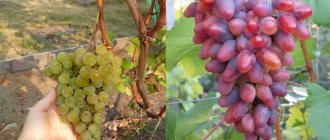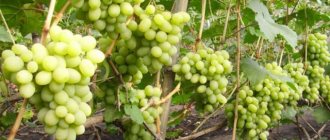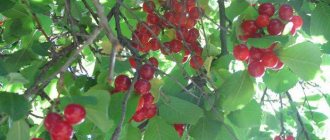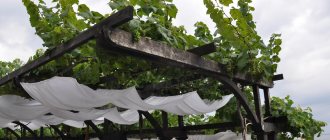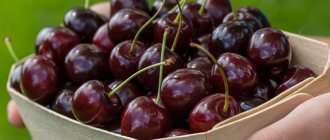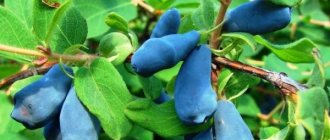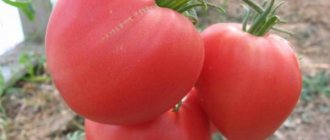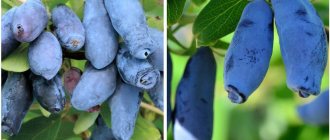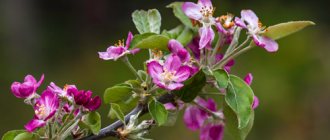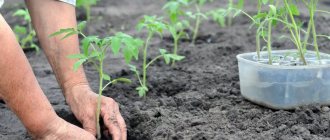History of selection
Malvina is a medium-early ripening honeysuckle bred at the Pavlovsk experimental station of the VIR named after. Vavilova N. I. (St. Petersburg). The parent forms of the new hybrid were plants of the elite form No. 21-5 from the Primorsky Territory and the Leningrad Giant variety. The authors of Malvina are considered to be M. N. Plekhanov and A. V. Kondrikov, and the variety was included in the State Register of Breeding Achievements of the Russian Federation in 2002 and is recommended for cultivation in any region of the country.
Did you know? The aroma of honeysuckle berries helps fight stress, reduces nervousness and improves mood.
Botanical description
Honeysuckle Malvina is represented by vigorous bushes, one and a half meters high. The crown of the plant is thick, squat, oval in shape. The skeletal branches are relatively thin and dark brown in color. The remaining shoots are light green, thin, erect, with slight pubescence on the surface of the bark. The dark green leaf blades of honeysuckle are large, dense, elongated-oval in shape with a point at the top.
The elongated pear-shaped berries of the variety are large, 2.9 cm long and weighing 1.1 g. Their bluish-blue surface is slightly tuberculate, without pubescence and with a slightly elongated base (a small uneven ridge is noticeable at the top). Under the dense skin with an intense waxy coating is hidden a fibrous pulp with a pleasant sweet and sour dessert taste. Its tasting score is 4.4 points.
Pros and cons of a hybrid
The disadvantages include:
- demands on watering;
- difficulty in separating berries from the stalk.
The hybrid has many more advantages than disadvantages. The following can be said about Malvina honeysuckle:
- it endures even the harshest winters;
- produces generous harvests of high quality berries;
- the fruits are large in size, have excellent taste, beautiful presentation and tolerate transportation well;
- the berries ripen in early June;
- plants almost never get sick;
- the berries do not fall off the bushes.
Pollinators
Malvina is a representative of self-sterile varieties of honeysuckle, so in order to obtain a harvest, you will have to plant other pollinating varieties on the site.
Important! When growing honeysuckle near an apiary, the rate of flower pollination increases, which means the yield of the bushes increases.
In this case, the most suitable options would be:
- Blue spindle;
- Blue bird;
- Moraine;
- Start;
- In memory of Kuminov;
- Kamchadalka.
Description and characteristics of the variety
Honeysuckle "Blue Bird" ripens early and is a universal variety. The variety produces very tasty and healthy fruits, which are considered one of the main advantages of the crop.
But it is important for gardeners to know the full description of the plant in order to navigate issues of agricultural technology
The bush is deciduous, erect, vigorous and spreading. The height of an adult plant is 1.2 m–1.4 m. If the agrotechnical requirements of the variety are carefully observed, the parameter increases to 2 m. This must be taken into account when planting the plant in small areas. The branches are thin, young shoots have salad-colored pubescence, while last year's shoots are covered with bark and acquire a reddish-brick hue. The plant reacts negatively to heat and winter thaw, but frosts or cold snaps at the time of flowering do not cause a decrease in the vital activity of the Blue Bird bush.
The crown of the bush is spreading, thickened and dense, shaped like a ball or ellipse. The crown diameter of an adult honeysuckle is 1.7 m–1.8 m.
The leaves resemble an oblong ellipse in shape. The color of the plates is light green, the surface is smooth and shiny.
The variety blooms very early, flowers appear immediately after the end of frost. They resemble yellowish bells in shape and grow in small bunches.
The berries of the variety are sweet with a pleasant aroma. Contain a large amount of nutrients and vitamins. The honeysuckle variety has an oval-elongated fruit shape, a blue-black color, the length of the berries is about 2 cm, the average weight is 0.8 g. The berries are universally used. They are good fresh and as preparations.
The yield of this honeysuckle variety is 1.6-1.7 kg per bush, which is considered an average for the crop.
The Blue Bird variety has high winter hardiness. The bush without shelter can withstand frost down to -30°C.
The plant is distinguished by its increased adaptive abilities to changes in growing conditions, good resistance to diseases and pests.
The variety is classified as self-sterile. Therefore, when growing Blue Bird honeysuckle bushes, it is necessary to plant pollinating varieties. Without fulfilling this condition, it will not be possible to obtain a decent harvest. It is better to take neighboring varieties recommended for pollination from the line of Kamchatka selection. According to reviews from gardeners, the following types of honeysuckle are suitable:
It is necessary to place at least 3 different varieties of honeysuckle on the site, then the yield of the bush will correspond to the description, and the berries will grow sweeter.
To attract as many natural pollinators as possible to the plant, gardeners spray the buds with a sweet solution. It is prepared from 10 liters of water and 50 g of honey.
Landing Features
Before planting Malvina on your site, it is worth determining the most suitable time for performing the procedure, choosing the most favorable place for the plant, selecting and preparing a seedling for planting. Of course, each of these actions must be performed in accordance with certain requirements.
Deadlines
For most central or even more so southern regions of the Russian Federation, the most suitable time for planting Malvina honeysuckle will be from August to November: approximately by the second summer month, the plant stops growing and begins a dormant period - the most favorable time for planting or replanting.
Due to the early start of the growing season, it is not recommended to plant the Malvina variety in the spring (the buds bloom already at the end of March). In rare cases, planting is still carried out, but only by transshipment method and in the southern regions of the country, where, with the rapid onset of heat, the plants will not react so painfully to a change in the place of growth.
Planting the Malvina variety
By its nature, honeysuckle is a forest plant, so the crop works well on loamy alkaline or neutral soils. For best fruiting, choose a sunny place protected from the winds. The crop will grow in the shade, but the yield will noticeably decrease.
Attention. Honeysuckle variety Malvina does not tolerate stagnant groundwater. High humidity has a detrimental effect on the roots, the plant begins to wither and soon dies.
The best time for planting crops is early autumn. By September, honeysuckle finishes its growing season and enters a dormant period, so it tolerates any changes in conditions painlessly and has time to adapt before frost.
It is not recommended to plant the plant in spring due to the early start of the growing season. Already in mid-March, the Malvina variety wakes up and produces buds. Any intervention during this period will lead to severe stress, and if there is insufficient care, even to the death of the bush.
Rules for planting honeysuckle
10–12 days before the start of planting work, holes are made in the selected area with a depth of 40 cm. The top layer of soil is mixed with a bucket of humus, 2 cups of ash and a matchbox of complete mineral fertilizer are added to the mixture. The composition is carefully shoveled and placed in the planting hole.
Advice. On acidic soils, add a handful of lime or a half-liter jar of chalk to the hole and water the soil well.
Step-by-step process of planting honeysuckle Malvina:
- A mound of fertile soil is poured into the center of the prepared hole;
- A seedling is placed on top, the roots are spread well and covered with nutritious soil. The container culture is transferred together with the earthen clod.
- The soil around the bush is compacted and watered;
- The tree trunk circle is mulched with peat, sawdust, and bark.
The root collar should not be buried more than 3 cm into the soil. In a wet year or when groundwater is high, it may dry out and the plant will die. After planting, young bushes are not pruned, like other fruit crops. The event slows down growth and reduces yield.
Rules of care
For abundant fruiting and maintaining the decorative appearance of the shrub, the Malvina variety needs regular watering, fertilizing and pruning of excess shoots. However, any of these actions must be carried out taking into account external factors, and primarily weather conditions.
Thus, liquid application is required only during prolonged drought, especially during fruit formation, immediately after harvest and before frost. In any other period, it is enough to water the bushes once a month, spending 10–15 liters of liquid per adult plant. Young, recently planted shrubs can be watered 2-3 times a month, but always taking into account the amount of natural precipitation.
The Malvina variety is undemanding when it comes to fertilizers, so in the first few years after planting the bushes do well without fertilizing - of course, provided that nutrients are added before planting.
Starting from the third year of cultivation, nitrogen-containing substances must be added to each bush, scattering them evenly in the circle around the trunk. On depleted clay soils, during the flowering of the bushes, a bucket of humus or compost is placed under each of them. In late autumn, potassium-phosphorus compounds are added to them in dry or liquid form.
The plant needs these substances to restore strength after previous fruiting and to form the rudiments of future ovaries. For one adult bush you will need 2 cups of ash and 1 tbsp. l. superphosphate in granules.
No less important for Malvina honeysuckle will be pruning of shoots, which in the first years of cultivation is performed only for sanitary purposes. With the arrival of spring, when a green cone appears, or in late autumn after harvesting, diseased, broken and improperly growing shoots must be removed.
From six-year-old bushes, 2-3 old shoots are cut out every year, replacing them with the same number of young branches. Thinning formation is best done in the autumn. All large areas where shoots are cut should be treated with garden varnish, thoroughly covering the entire area of the damage.
How to grow honeysuckle Malvina
Let's start with the main feature of the variety - the need to plant pollinator varieties. Honeysuckles such as Morena, Blue Bird, Pamyati Kuminova, Blue Spindle, Start, Kamchadalka and the Malvina variety have proven themselves well. It is enough to plant 3 or 4 bushes at a distance of 2 meters from each other, you can choose any scheme, it does not matter whether the honeysuckles grow in a row or in a group.
The planting rules are usual; you should choose a bright, spacious place with loose, non-acidic and non-waterlogged soil; the variety is not afraid of cold winds, but in the shade, even sparse, the yield decreases. Malvina adapts well to any type of soil, but it gives the best results on fertile, cultivated loams. Planting is carried out from late summer to mid-autumn, the place is prepared in advance - it is improved and fertilized.
You may be interested in: Secrets of growing goji in the open ground and features of caring for the shrub. What is yoshta, what are the benefits of the berry and how to grow a shrub in the open ground Edible honeysuckle: planting and caring for the plant
How to choose a seedling
Planting material must be purchased from local fruit nurseries, where there is a wide selection of already adapted varieties. Pollinators should be selected immediately. The best purchase will be two-year-old bushes with well-developed, flexible 2-3 branches with buds. The root must be strong, without damage; if the tree is sold in a container, pay attention to the surface of the soil; the presence of mold will be a bad sign.
Watering and fertilizing
For the first couple of years, the bushes do not need to be fertilized; watering is carried out periodically and the soil around the trunk is carefully loosened. Subsequently, in early spring, honeysuckle is fed with nitrogen, when the buds begin to bloom, organic matter is added, and during the flowering period, the tree trunk circles are watered with ash infusion. At the end of the season, a complex fertilizer is prepared - a mixture of 5 kilograms of compost, 200 grams of ash and 40 grams of superphosphate.
During the entire season, the bushes are watered no more than 6 times; during normal periods, 15 liters of water are enough; at the end of May and the beginning of June, the amount of moisture is increased. In dry weather and during the fruit-filling period, at least 3 buckets of water are used for one plant. You can reduce moisture evaporation by adding a small layer of straw or dry grass.
Trimming
Shaping of the bush is carried out from the third year after planting; Malvina honeysuckle is prone to thickening. No more than 5 of the strongest branches are left on the bushes; excess small branches, tops and root shoots are also cut off. The procedure can be carried out only after the leaves have fallen. In subsequent years, sanitary pruning is needed; only dry or diseased branches are removed.
A slight decrease in the yield of the variety is observed 7–9 years after planting; it’s time to carry out rejuvenating pruning. In one season, 2 old branches are removed (at the root) and replaced by 3 young shoots; the procedure is repeated the next year.
Diseases and pests
In rainy and cool summers, even the hardiest plants get sick; Malvina honeysuckle can suffer from powdery mildew. During dangerous periods, the bush should be treated with systemic fungicides. The appearance of pests for the variety is very rare, but with severe invasions of neighboring fruit and berry crops there is a risk of damage by aphids, whiteflies or scale insects. You can drive away insects using drugs such as Actellik or Fitoverm.
Collection and storage of berries
The fruits are picked in several stages; for transportation and storage, it is better to collect them at technical ripeness. The harvested crop can be stored for up to 2, and sometimes up to 3 weeks; it is advisable to keep the berries in the refrigerator and not in a cool room. During transportation, the fruits, due to their dense consistency, retain their shape, do not wrinkle, and due to the elastic skin, they do not crack.
Fully ripened berries do not last long; they are immediately eaten or sent for processing. Selecting the right fruits in bunches is a little difficult, but the procedure is simplified by the fact that the short stalk holds tightly to the shoots, and the berries can only fall off when they are very overripe.
Honeysuckle Malvina has long been loved by gardeners, this is not surprising, the list of positive qualities is amazing. The variety is very unpretentious and does not cause unnecessary trouble when growing, and also consistently pleases with good harvests of very tasty and beautiful berries. The decorative appearance of the bush allows it to be used to decorate a summer cottage.
Harvesting and storage
Honeysuckle berries of the described variety are harvested according to the general scheme: by hand, at the stage of full ripening, which in this case most often occurs at the beginning of July. In the refrigerator, picked fruits retain all their qualities for three weeks, especially if they are picked a few days before full ripeness.
When overripe, the shelf life of honeysuckle does not exceed 3-4 days, but this will be quite enough to transport the crop.
Fruits of the Malvina variety tolerate transportation well and can be moved even over long distances, however, only if there are appropriate boxes (preferably with holes for filtration). Dense containers will not allow the berries to lose their shape and attractive appearance.
Honeysuckle Malvina - variety description, reviews and photos
Honeysuckle is a garden berry, which is one of the first to ripen in our garden plots.
While we are waiting for the strawberries and raspberries, cherries and currants to ripen, we will already have time to enjoy the first berries that have ripened in our gardens. Children, who have been yearning for something tasty throughout the long winter, are especially happy about the early harvest of berries. Previously, few gardeners knew about such a crop as honeysuckle, which was considered a wild plant. Now more and more new hybrids of this berry are being developed. Honeysuckle Malvina is one of the best representatives of its genus, which pleases with its unpretentiousness and early ripening of berries.
Photo of honeysuckle Malvina.
What does Malvina honeysuckle look like and what are its characteristics?
Honeysuckle Malvina was bred in the city of St. Petersburg by breeders M. Plekhanova and A. Kondrikova by crossing an elite variety number 21-5, originally from the Primorsky Territory, with honeysuckle Leningradsky Velikan. The hybrid was registered in the State Register in 2002. Designed for cultivation throughout Russia.
Description of the plant
Malvina bushes not only produce delicious berries. They are decorative and will decorate any dacha or garden plot:
- hybrid plants are characterized by tall growth and large size. The bush reaches a height of 1.5 meters;
- thin, straight green shoots and strong branches, painted brown, are abundantly covered with dense and large oval-shaped leaves with pointed ends. The leaves are dark green, smooth, without jagged edges;
- the bushes have a dense, squat crown of a round or oval shape;
- the flowers are small pale yellow bells. Inflorescences are bunch-shaped;
- plants begin to bloom immediately after the snow melts;
- honeysuckle Malvina requires other varieties of crops for pollination, which include Morena, Malvina, Start, Blue Bird or Blue Spindle;
- bushes grow slowly. Only after 4 years the plant grows up to 1 meter tall. Honeysuckle begins to bear fruit 3-4 years after planting;
- Bushes live for 25 years or more.
Description of berries
The fruits of the hybrid grow quite large for this crop:
- The length of the berry is about 3 cm, the width is no more than 1.2 cm. The weight of the berry is about 1 g;
- the fruits have an elongated, slightly tuberous shape and a bluish-blue color with a bluish waxy coating;
- The fibrous, delicate pulp is covered with a dense skin. The aroma of berries is weak;
- the taste is very pleasant, sweet and sour without bitterness.
Taste qualities are rated 4.4 points on a five-point scale.
Valuable properties of honeysuckle
The fruits of the Malvina hybrid are not only very tasty, but also very healthy. They are used in alternative medicine to treat a range of diseases. The benefits of berries are due to their incredibly rich chemical composition. 100 g of fruit pulp contains:
- sugar - about 15%;
- acids - no more than 1.9%;
- vitamin C - up to 52 mg;
- dry matter - 17.3%.
In addition, honeysuckle is rich in:
- vitamins A, group B, PP;
- malic, succinic, oxalic, citric acids;
- tannins;
- pectin;
- catechins;
- glycosides;
- micro- and macroelements - phosphorus, calcium, potassium, fluorine, sodium, magnesium, iron, copper, zinc, iodine, silicon, etc.
Honeysuckle berries increase appetite, strengthen the immune system, eliminate vitamin deficiency, and cleanse toxins. They are used for:
- diseases of the heart and blood vessels;
- diseases of the stomach and liver;
- rheumatism, gout and arthritis;
- skin diseases;
- colds and infections;
- diseases of the throat and respiratory organs;
- kidney stones and gall bladder stones.
The fruits of the plant are used to treat hypertension, diabetes, and atherosclerosis. Constant use of honeysuckle in food will improve blood composition, cleanse blood vessels of cholesterol plaques, normalize metabolism, restore vision, strengthen hair, and rejuvenate the skin.
Usage
Fresh berries are a storehouse of vitamins and other useful substances. Both adults and children love them. Jams, jellies and jams are made from honeysuckle berries. They make jelly and compote and squeeze out the juice. The fruits are dried and used to make homemade wine.
When it ripens
Malvina begins to ripen very early. Already in early June you can taste the first berries. In the middle of the month you can start harvesting. The fruits can hang on the bushes for a long time. At the same time, they will not crumble and will not lose their taste or appearance. The berries come off the stems poorly.
Yield indicators
Malvina produces high yields. From a bush over 6 years old, 1.5 to 3.5 kg of delicious berries are harvested. From one hectare - about 49 centners of fruit.
Shelf life of berries and their transportation
The berries can be stored in the refrigerator for up to 3 weeks if they are picked a few days before they are fully ripe. Fully ripe berries are stored for only 2-3 days. The Malvina variety tolerates transportation well. They can be transported over long distances with high-quality packaging. At the same time, they will not crack or wrinkle.
Weather resistance
Hybrid Malvina thrives in extreme winter temperatures. Its bushes tolerate frosts down to -50°C. The root system of plants does not freeze at -40°C, and flowering buds can withstand return frosts down to -8°C.
Honeysuckle is resistant to adverse weather conditions. She does not suffer from temperature changes. The only drawback is the lack of resistance to drought and the requirement for watering.
Malvina honeysuckle grows throughout our country, including in its northern regions.
Protection from diseases and pests
This hybrid almost never gets sick. The exception is damp and cool summers. This is when there is a risk of plant damage:
- powdery mildew. A felt coating appears on the leaves on both sides, and then black spots that increase in size over time. Gradually the leaves dry out and fall off. The berries of diseased plants become deformed. To prevent the bushes from getting sick, they are sprayed several times a season with the fungicides Tiovit Jet, Skor, Rayok or Chistotsvet;
- fungal diseases (brown spot, light gray spot, ascochyta spot), signs of which are irregularly shaped brown, grayish or blackish-gray spots on the leaves that can merge. A whitish coating consisting of fungal spores appears on the underside of the leaves. The leaves begin to dry out and fall off. To prevent fungal diseases, bushes are treated with 1% Bordeaux mixture or fungicides Abiga Pik or Khom.
Insects that can harm honeysuckle include spider mites and aphids. Bushes are protected from ticks by spraying with insecticides Actellik, Fitoverm, Molniya, Kemifos, etc. Honeysuckle will be protected against aphids by treatment with Iskra, Inta Vir, Fufanon or Karbofos.
Pros and cons of a hybrid
The disadvantages include:
- demands on watering;
- difficulty in separating berries from the stalk.
The hybrid has many more advantages than disadvantages. The following can be said about Malvina honeysuckle:
- it endures even the harshest winters;
- produces generous harvests of high quality berries;
- the fruits are large in size, have excellent taste, beautiful presentation and tolerate transportation well;
- the berries ripen in early June;
- plants almost never get sick;
- the berries do not fall off the bushes.
Source: https://sovhozik.ru/shrubs/zhimolost/zhimolost-malvina-opisanie-sorta-otzyvy-i-foto
Preparing for winter
Considering the high winter hardiness of honeysuckle bushes, serious shelter is required only for young plants, and then in rare cases. However, this does not mean that preparing for the winter season is not important for plants. About 2 weeks before the expected frost, the bushes are watered abundantly, adding at least 30 liters of liquid under each adult plant. After this, the tree trunk area can be mulched with a layer of compost.
If the winter was very frosty and temperatures reached -40°C, there may be slight freezing of the apical parts of young shoots, which will have to be cut back to healthy tissue when spring arrives.
Video: preparing honeysuckle for winter
Agricultural technology for cultivating honeysuckle
The first two seasons you only need to water, loosen and mulch the soil. Young plants do not need fertilizing or pruning.
Watering and loosening
Honeysuckle does well in regions with high humidity and needs regular watering, especially in dry summers. The bushes are moistened 5–6 times per season, spending an average of 15 liters per plant. It is better to use settled water heated in the sun. With a lack of moisture, the taste of the berries deteriorates. Abundant watering is especially necessary in late May - early June - it helps to increase the yield and increase the weight of berries by 15%. When filling fruits in dry weather, the volume of water is increased to 3 buckets per bush.
Water is applied into watering grooves made around the bush, or using a hose with a sprayer. However, during the flowering period, sprinkling is not carried out so as not to wash off the pollen from the flowers.
Honeysuckle is a moisture-loving plant that needs regular watering.
After watering or rain, the damp soil is loosened shallowly, trying not to damage the roots that emerge close to the surface. You can reduce moisture evaporation and stop the growth of weeds by mulching with hay, straw, and compost.
Reproduction methods
Planting a purchased young honeysuckle plant on a plot of land is the first step towards obtaining a crop harvest, and in the future you will no longer have to buy new plants: it is enough to correctly propagate the existing ones. There are several possible ways to obtain new plants:
- Green cuttings. They begin to harvest the required lengths of shoots immediately after they bloom, cutting 12-centimeter cuttings from healthy green shoots. After cutting, they are planted in a container with fertile soil, well moistened and covered with film, leaving for further rooting at a temperature within +25°C. Every day, the improvised shelter should be removed to ventilate the plantings, preventing the soil from drying out. Already next fall it will be possible to transplant the stronger seedlings to a permanent place in the garden.
The survival rate of such cuttings is higher than that of lignified segments, which are harvested mainly at the end of leaf fall, dividing annual shoots into 20-centimeter parts. They are stored in sand or sawdust all winter, after which they are planted in a greenhouse at an angle of 45° and watered regularly. They are moved to a permanent place of growth next fall. - By layering. This is one of the easiest ways to propagate honeysuckle. Planting material begins to be harvested at the end of June, bending the top of the shoots to the ground and covering it with a 5-centimeter layer of soil. To fix the shoot in this position, it is pinned with metal clips, after which it is watered abundantly throughout the summer. By autumn, the dug part will have its own roots, which means it can be separated from the mother bush and planted in a prepared area.
- Dividing the bush. When using this propagation method, you first need to dig up a bush (no older than five years old) and divide it into several parts so that they all have their own root system. In the future, each of them needs to be planted as an independent plant, providing appropriate care.
Some gardeners are also considering the seed method of growing honeysuckle, but this option is the most labor-intensive and often ends in failure. For this reason, in order to get an adult plant as quickly as possible, it is better to use the method of cuttings or dividing the bush.
Diseases and pests
Plants of the Malvina variety are practically not susceptible to disease, however, in cold and very humid summers, fungal diseases and pest damage may occur, among which aphids, whiteflies, scale insects and spider mites are the most common.
Among the diseases the plant is afraid of are powdery mildew and rust , primarily noticeable by changes in the color of the leaf plates or shoots of the plant. In the first case, a gray-white coating appears on them, and in the second, yellow spots grow strongly over the surface of the honeysuckle bush. In the fight against diseases, systemic fungicides are used, the most effective of which are “Topaz”, “Skor”, “Alto”, “Folikur”.
Insecticidal compounds “Inta-Vir”, “Fitoverm”, “Aktellik” will help get rid of insect pests, and to stimulate the plant’s defenses it is worth using “Epin” or “Zircon”, which are sprayed on the crown of the crop. The dosage and methods of preparing the working composition are always indicated by the manufacturer on the packaging.
All chemical treatments can be performed only after harvesting, or before the appearance of ovaries on the shoots. As a last resort, in case of urgent need, “Fitosporin” and “Glyokladin” are used, the treatment with which is carried out during the ripening of the berries.
Honeysuckle variety Malvina has truly deservedly received universal recognition among gardeners. The relatively early ripening of fruits, the attractive appearance of the bushes and the ease of caring for the crop made it an excellent option for universal cultivation: not only for culinary, but also for decorative purposes, which is very important when designing a garden.
Advantages and disadvantages
The only significant disadvantages include self-sterility; otherwise, Malvina has only positive qualities:
- weak crumbling;
- endurance, the variety is not afraid of either heat or frost;
- immunity to diseases and pests;
- convenient bush habit, decorativeness;
- ease of care;
- excellent taste and commercial quality of berries.
Gardeners from the northern regions, first of all, appreciate Malvina for the fact that even in unfavorable conditions it consistently produces very high yields.

